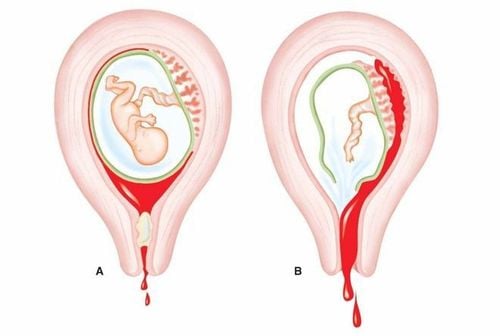This is an automatically translated article.
The article was professionally consulted by BSCKI Le Thi Phuong - Department of Obstetrics and Gynecology, Vinmec Ha Long International Hospital.Cervicitis is one of the common gynecological diseases. In Vietnam, up to 33% of women have this disease, of which up to 40% have severe complications that turn into cervical ulcers, which can lead to the risk of cervical cancer. What are the causes, symptoms, and treatment of cervicitis?
1. What is cervicitis?
Cervicitis is a swelling, inflammation, and sores in the cervix caused by agents such as bacteria, fungi, or parasites. The disease is divided into two categories, acute and chronic. Acute cervicitis when recurrent or not detected and treated promptly can lead to chronic cervicitis.Manifestations of cervicitis are quite similar to vaginitis: milky white discharge, unpleasant odor, itching, vaginal bleeding, burning sensation during sex. The cause of this pathology is usually a bacterial infection.
Cervicitis is a disease that is not difficult to cure, but if not treated, the disease has the risk of reducing the immune function of the uterus and vagina, increasing the likelihood of contracting sexually transmitted diseases such as gonorrhea , syphilis , Chlamydia infection , ... even HIV infection .
2. Signs of cervicitis
Many women with cervicitis do not have any symptoms. Therefore, the disease is often detected during routine check-ups or the patient comes to the clinic for another related illness.Signs and symptoms of cervicitis include:
Unusual discharge: yellow, milky or light gray. Unusual vaginal bleeding, such as bleeding after sex or between periods. Vaginal pain and itching. Pain during sex. Pain when urinating.

3. Causes of cervicitis and how to prevent it
Most cases of cervicitis are caused by a sexually transmitted infection. Taken together, cervicitis causes can stem from the following:3.1. Unprotected intercourse Cervicitis often comes from causes related to unsafe sex, which can be listed as:
Not using condoms : Increases the risk of parasitic infections, sexually transmitted infections and viruses. Intercourse is too rough: Causing damage to the cervix, creating conditions for infection to develop. Having sex with a partner who has a sexually transmitted disease such as gonorrhea, syphilis, genital warts, genital warts. As such, you need to take precautions when having sex. Here are some tips for women:
Always use protection such as condoms (for men), IUDs,... and use them correctly. Limit the number of "sex partners". Have a frank discussion with your partner to prevent sexually transmitted diseases. Say "no" when you're not ready. Limit yourself while using stimulants. 3.2. Vaginitis Vaginitis if not treated in time can create an opportunity for parasites, fungi, and bacteria to attack the cervix and cause infection, more dangerous than the risk of cervical cancer. uterus .
To limit the cause of vaginitis leading to cervicitis, women should regularly use toilet paper, wash the vulva properly after intercourse, change tampons during menstruation, choose materials proper underwear and change them more often.
3.3. Allergies The use of personal hygiene solutions, condoms, and lubricants of unknown origin and improper use make the "girl" allergic and likely to cause cervicitis.
To avoid risks, couples need to use lubricants for the right purpose, use condoms of the right size, choose the right material for the body to avoid allergies.
3.4. Abortion Women with a history of abortion are more likely to have cervicitis. Especially in cases of unsafe abortion, poor post-operative care is the cause of cervical infection.
Abortion is the cause of cervicitis. Choosing a reputable medical facility to perform safe abortion procedures is extremely important, helping a woman to minimize complications and avoid affecting the future birth.
3.5. Sex too early, too much Women start having sex too young, leading to early pregnancy while reproductive organs are not fully developed. Besides, continuous intercourse with high frequency, having many different sexual partners at a time increases the risk of gynecological diseases. On the other hand, a woman who is faithful but has a partner or husband has promiscuous sex with many different people. All of these can be the cause of cervicitis.
For the sex story, couples, in addition to using safety measures to protect themselves, also need to have moderate and moderate sex.
3.6. Poor personal hygiene Cervical infection can also be caused by unclean and improper personal hygiene, such as wearing clothes for a long time, the habit of wearing tight pants, use water to wash deeply into the vulva, do not clean the genitals before and after intercourse,...
To limit vaginal infections, you need to create a habit of maintaining good hygiene Will, diligently use cleaning solutions and must use them correctly.
3.7. The menstrual cycle is abnormally long In some women, the menstrual period is sometimes abnormally long (over 7 days), causing menorrhagia, heavy bleeding, making the cervix always open. create conditions for bacteria, fungi to enter, causing cervicitis.
For this condition, you need to talk with a gynecologist to determine the exact cause and treat it in time, to avoid the disease becoming more persistent and serious.

4. Methods of treating cervicitis
Use of drugs Depending on the source of the cause of cervicitis, the doctor will prescribe the appropriate drug. If you have cervicitis caused by a sexually transmitted disease, your doctor will prescribe antibiotics to treat that infection. In cases of cervicitis caused by a virus (such as genital herpes), doctors usually prescribe antiviral medication.One thing to keep in mind, is that cervicitis testing and treatment should also be applied to your sexual partners, whether they show symptoms or not.
Laser Therapy Similar to heat therapy, cervicitis laser therapy uses a high-intensity laser to burn and destroy abnormal tissue. The patient was anesthetized and lying stable in the preparation position. The doctor uses a device to keep the vagina open, and then a laser is directed at the abnormal tissue.
Electrocautery Electrocautery (also called thermotherapy) is an outpatient procedure that burns away infected cells inside the cervix. After the patient is stabilized in the preparation position, the doctor will use the device to hold the vagina open. Next, a specialized cotton swab is inserted to clean the cervix, then the doctor uses a heat stick to destroy the diseased tissue.
For this procedure, the patient will need a local anesthetic to reduce discomfort before the procedure.
Cryosurgery In case of persistent cervicitis, the doctor will most likely use cryosurgery, also known as cryotherapy. This is a procedure that uses extreme cold to destroy abnormal cells. The instrument used was a cryogenic rod containing liquid nitrogen.
Cryosurgery is almost painless, but the patient can experience cramping, bleeding, infection, and scarring at worst.
Currently, at Vinmec International General Hospital, we are implementing the Basic Gynecological Examination and Screening Package, helping customers to detect early infectious diseases for easy and inexpensive treatment; Screening for early detection of gynecological cancer (cervical cancer).
With a team of experienced gynecologists at Vinmec hospital, ready to examine and treat you. When you see the symptoms of cervicitis, you should go to the doctor and treat as soon as possible to avoid trouble in daily life.
Please dial HOTLINE for more information or register for an appointment HERE. Download MyVinmec app to make appointments faster and to manage your bookings easily.














